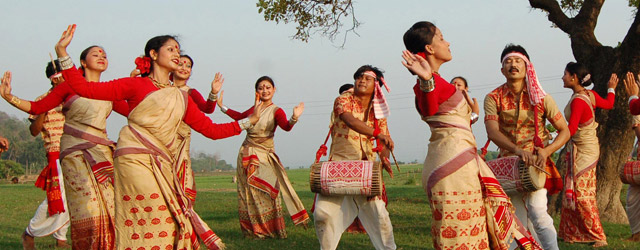Rongali Bihu | 15 Apr 2025
Why in News?
Rongali Bihu, also known as Bohag Bihu, is celebrated across Assam from 14th to 20th April 2025, marking the Assamese New Year and the beginning of the harvesting season.
What are the Key Features of Rongali Bihu?
- About: Rongali Bihu is the most prominent of the three Bihus celebrated annually in Assam, the other two being Kati Bihu (October) and Magh Bihu (January).
- Rongali Bihu signifies the beginning of the Hindu solar calendar and is thus celebrated as the Assamese New Year.
- Primarily a harvest festival, it marks the onset of spring, with prayers for a prosperous agricultural season.
- Etymology: "Rong" means joy in Assamese, reflecting the festival’s cheerful spirit.
- Celebrations: The Bihu dance (vibrant, fast-paced folk dance from Assam) is performed to the rhythm of folk songs and traditional instruments such as the dhol, pepa, gogona, toka, taal, and hutuli.
- Other Bihus:
|
Festival |
Timing |
Significance |
|
Rongali Bihu |
April (Bohag) |
Start of sowing season, Assamese New Year |
|
Kati Bihu |
October (Kati) |
Mid-crop season, prayers for good harvest |
|
Magh Bihu |
January (Magh) |
End of harvest, community feasts |
New Year Celebrations Across Indian States
- Baisakhi: Marks the beginning of the spring harvest season in Punjab and Northern India.
- Puthandu: Celebrated in Tamil Nadu and by Tamil communities worldwide. It falls on the first day of Chithirai month in the Tamil calendar.
- Pohela Boishakh: Celebrated in West Bengal, marking the start of the Bengali calendar year.
- Jude Sheetal: Celebrated by Maithili communities in Bihar, Jharkhand, and Nepal.
- Pana Sankranti: Celebrated in Odisha as the Odia New Year. It is known for the traditional drink Bela Pana made from bael fruit ((wood apple).
- Vishu: Celebrated in Kerala and parts of Tamil Nadu, it marks the Sun’s transition into Mesha Rashi.
- Ugadi: Observed in Andhra Pradesh, Telangana, and Karnataka as the start of the Hindu New Year.
- Ugad derived from Sanskrit, “Yuga” (age) and “Adi” (beginning) together mean “the beginning of a new age.”
- Gudi Padwa: Celebrated in Maharashtra and Goa as Samvatsar Padvo. It marks the beginning of the Marathi New Year and the first day of the Chaitra month.
- Navreh: Observed by Kashmiri Pandits to mark their traditional New Year. Navreh derived from Sanskrit “Nava Varsha”, meaning “new year”.
- Sajibu Cheiraoba: Celebrated in Manipur by the Meitei community. It marks the beginning of the Manipuri lunar calendar year.
- Bestu Varas: Celebrated in Gujarat as New Year and is observed a day after Diwali as part of the five-day festive celebrations.
| Read more: New Year Festivals Across India, Harvest Festivals |


